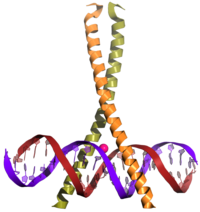CREB

CREB (cAMP response element-binding) proteins are transcription factors which bind to certain sequences called cAMP response elements (CRE) in DNA and thereby increase or decrease the transcription of certain genes. CREB proteins are active in many animals, including humans. The typical (somewhat simplified) sequence of events is as follows: a signal arrives at the cell surface, activates the corresponding receptor, which leads to the production of a second messenger such as cAMP or Ca2+, which in turn activates a protein kinase. This protein kinase moves to the cell nucleus, where it activates a CREB protein. The activated CREB protein then binds to a CRE region, and is then bound to by a CBP (CREB binding protein) which coactivates it, allowing it to switch certain genes on or off. The DNA binding of CREB is mediated via its basic leucine zipper domain (bZIP domain) as depicted on the picture.
CREB proteins in neurons are involved in the formation of long-term memories; this has been shown in the marine snail Aplysia, the fruit fly Drosophila melanogaster, and in rats. They are necessary for the late stage of long term potentiation. There are activator and repressor forms of CREB. Flies genetically engineered to overexpress the inactive form of CREB lose their ability to retain long term memory.
In humans, abnormalities of the CREB protein gene CBP is associated with Rubenstein-Taybi syndrome.
References
"Opening Skinner's Box" by Laren Slater
Barco, A., Bailey, C. H., & Kandel, E. R. (2006). Common molecular mechanisms in explicit and implicit memory. Journal of Neurochemistry, 97, 1520-1533.
Yin, J. C., Del Veccio, M., Zhou, H., & Tully, T. (1995). CREB as a memory modulator: induced expression of a dCREB2 activator isoform enhances long-term memory in Drosophila. Cell, 81, 107-115.
Yin, J. C., Wallach, J. S., Del Veccio, M., Wilder, E. L., Zhou, H., Quinn, W. G., et al. (1994). Induction of a dominant negative CREB transgene specifically blocks long-term memory in Drosophila. Cell, 79, 49-58.
Links
Johannessen, M., Pedersen Delghandi, M., and Moens, U. (2004) - What Turns CREB on ? - Cell Signall.; 10:1211-1227. http://www.sigtrans.org/publications/what-turns-creb-on/
